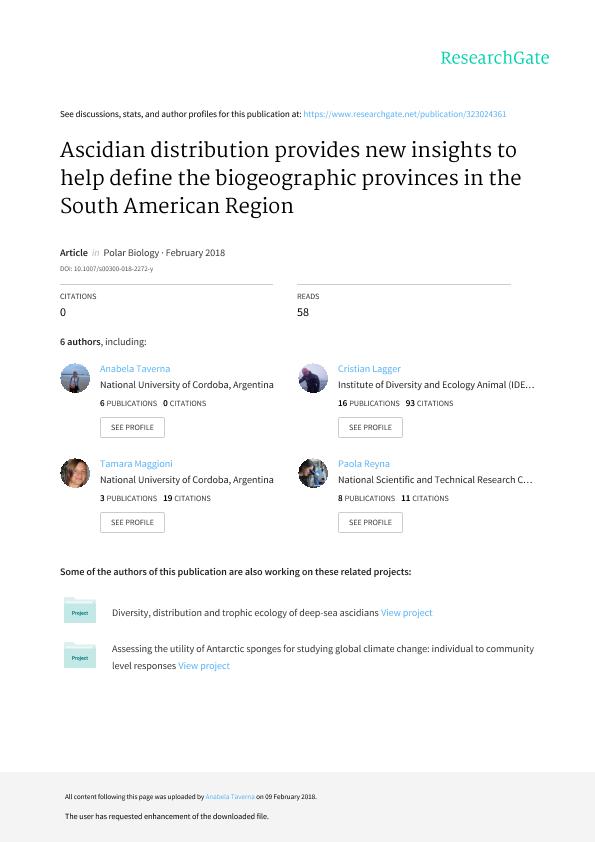Mostrar el registro sencillo del ítem
dc.contributor.author
Taverna, Anabela Jesús

dc.contributor.author
Lagger, Cristian Fabian

dc.contributor.author
Maggioni, Tamara

dc.contributor.author
Reyna, Paola Beatriz

dc.contributor.author
Lovrich, Gustavo Alejandro

dc.contributor.author
Tatian, Marcos

dc.date.available
2019-10-23T17:37:03Z
dc.date.issued
2018-06
dc.identifier.citation
Taverna, Anabela Jesús; Lagger, Cristian Fabian; Maggioni, Tamara; Reyna, Paola Beatriz; Lovrich, Gustavo Alejandro; et al.; Ascidian distribution provides new insights to help define the biogeographic provinces in the South American Region; Springer; Polar Biology; 41; 6; 6-2018; 1123-1131
dc.identifier.issn
0722-4060
dc.identifier.uri
http://hdl.handle.net/11336/87096
dc.description.abstract
The validity and size of the biogeographic Magellan Province of marine organisms have been the focus of discussion of many authors. The distribution of fish and other organisms has revealed a lack of homogeneity in the area, which has also been interpreted as comprising four different Provinces: Southern Chile (SCH), Tierra del Fuego (TDF), Southern Argentina (SAR), and the Malvinas/Falkland Islands (MAI). For the first time, we assess the ascidian fauna of this region to determine if the distribution of benthic sessile filter feeders corresponds to these biogeographic provinces. Ascidian species richness and percentages of endemism for these four areas were estimated using data from the literature and new sampling. Biogeographic affinities among SCH, TDF, SAR, and MAI were also calculated. The species Pyura pilosa, Molgula malvinensis, and Molgula manhattensis, the latter frequently considered as invasive, were found for the first time on the TDF shelf. The highest ascidian species richness was found in TDF (70 species), while the percentages of endemism greater than 10% (the minimum to qualify an area as a province) were found in TDF (15.7%) and SCH (11.1%). SAR and MAI showed the lowest percentages of endemism and the strongest affinity. Based on percentages of endemism, faunal affinities, and differences among the four provinces, we propose a separation of the South American Region into three Provinces: SCH, TDF, and SAR/MAI. Continued sampling of ascidians is considered to be particularly important, given the potential spread of invasive species throughout this region.
dc.format
application/pdf
dc.language.iso
eng
dc.publisher
Springer

dc.rights
info:eu-repo/semantics/openAccess
dc.rights
Atribución-NoComercial-CompartirIgual 2.5 Argentina (CC BY-NC-SA 2.5 AR)
dc.rights.uri
https://creativecommons.org/licenses/by-nc-sa/2.5/ar/
dc.subject
ASCIDIACEA
dc.subject
BIOGEOGRAPHY
dc.subject
MAGELLAN
dc.subject
SOUTH AMERICAN REGION
dc.subject
BIOLOGICAL INVASION
dc.subject.classification
Biología Marina, Limnología

dc.subject.classification
Ciencias Biológicas

dc.subject.classification
CIENCIAS NATURALES Y EXACTAS

dc.title
Ascidian distribution provides new insights to help define the biogeographic provinces in the South American Region
dc.type
info:eu-repo/semantics/article
dc.type
info:ar-repo/semantics/artículo
dc.type
info:eu-repo/semantics/publishedVersion
dc.date.updated
2019-10-16T14:25:05Z
dc.identifier.eissn
1432-2056
dc.journal.volume
41
dc.journal.number
6
dc.journal.pagination
1123-1131
dc.journal.pais
Alemania

dc.description.fil
Fil: Taverna, Anabela Jesús. Consejo Nacional de Investigaciones Científicas y Técnicas. Centro Científico Tecnológico Conicet - Córdoba. Instituto de Diversidad y Ecología Animal. Universidad Nacional de Córdoba. Facultad de Ciencias Exactas Físicas y Naturales. Instituto de Diversidad y Ecología Animal; Argentina
dc.description.fil
Fil: Lagger, Cristian Fabian. Consejo Nacional de Investigaciones Científicas y Técnicas. Centro Científico Tecnológico Conicet - Córdoba. Instituto de Diversidad y Ecología Animal. Universidad Nacional de Córdoba. Facultad de Ciencias Exactas Físicas y Naturales. Instituto de Diversidad y Ecología Animal; Argentina
dc.description.fil
Fil: Maggioni, Tamara. Consejo Nacional de Investigaciones Científicas y Técnicas. Centro Científico Tecnológico Conicet - Córdoba. Instituto de Diversidad y Ecología Animal. Universidad Nacional de Córdoba. Facultad de Ciencias Exactas Físicas y Naturales. Instituto de Diversidad y Ecología Animal; Argentina
dc.description.fil
Fil: Reyna, Paola Beatriz. Consejo Nacional de Investigaciones Científicas y Técnicas. Centro Científico Tecnológico Conicet - Córdoba. Instituto de Diversidad y Ecología Animal. Universidad Nacional de Córdoba. Facultad de Ciencias Exactas Físicas y Naturales. Instituto de Diversidad y Ecología Animal; Argentina
dc.description.fil
Fil: Lovrich, Gustavo Alejandro. Consejo Nacional de Investigaciones Científicas y Técnicas. Centro Austral de Investigaciones Científicas; Argentina
dc.description.fil
Fil: Tatian, Marcos. Consejo Nacional de Investigaciones Científicas y Técnicas. Centro Científico Tecnológico Conicet - Córdoba. Instituto de Diversidad y Ecología Animal. Universidad Nacional de Córdoba. Facultad de Ciencias Exactas Físicas y Naturales. Instituto de Diversidad y Ecología Animal; Argentina
dc.journal.title
Polar Biology

dc.relation.alternativeid
info:eu-repo/semantics/altIdentifier/url/https://link.springer.com/article/10.1007%2Fs00300-018-2272-y
dc.relation.alternativeid
info:eu-repo/semantics/altIdentifier/doi/https://doi.org/10.1007/s00300-018-2272-y
Archivos asociados
